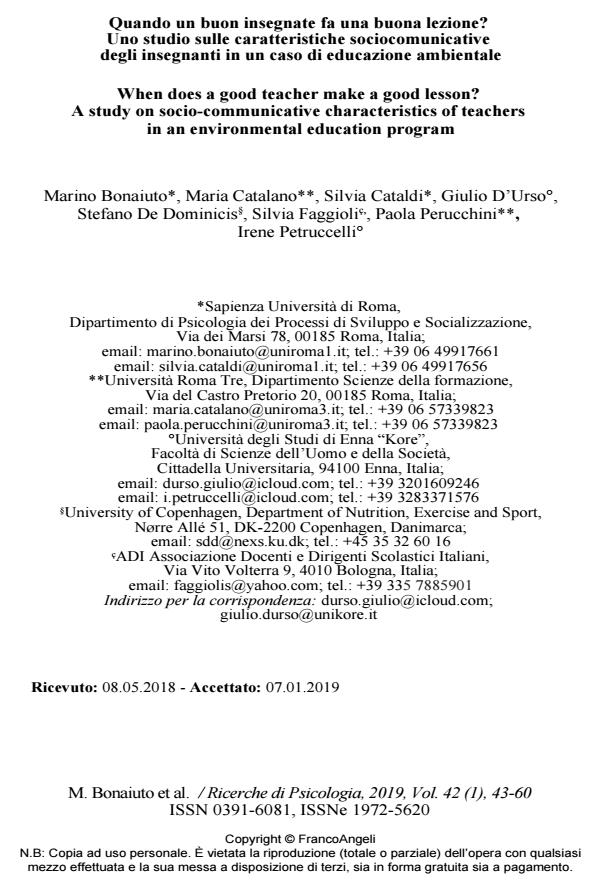Quando un buon insegnate fa una buona lezione? Uno studio sulle caratteristiche sociocomunicative degli insegnanti in un caso di educazione ambientale
Titolo Rivista RICERCHE DI PSICOLOGIA
Autori/Curatori Marino Bonaiuto, Maria Catalano, Silvia Cataldi, Giulio D’Urso, Stefano De Dominicis, Silvia Faggioli, Paola Perucchini, Irene Petruccelli
Anno di pubblicazione 2019 Fascicolo 2019/1
Lingua Italiano Numero pagine 18 P. 43-60 Dimensione file 219 KB
DOI 10.3280/RIP2019-001003
Il DOI è il codice a barre della proprietà intellettuale: per saperne di più
clicca qui
Qui sotto puoi vedere in anteprima la prima pagina di questo articolo.
Se questo articolo ti interessa, lo puoi acquistare (e scaricare in formato pdf) seguendo le facili indicazioni per acquistare il download credit. Acquista Download Credits per scaricare questo Articolo in formato PDF

FrancoAngeli è membro della Publishers International Linking Association, Inc (PILA)associazione indipendente e non profit per facilitare (attraverso i servizi tecnologici implementati da CrossRef.org) l’accesso degli studiosi ai contenuti digitali nelle pubblicazioni professionali e scientifiche
Il presente lavoro ha lo scopo di verificare se e quali modalità didattiche e in-terattive messe in atto dall’insegnante in classe, durante le lezioni, possano essere un fattore legato alle buone relazioni insegnanti-discente, nonché un fattore lega-to allo sviluppo di proficue relazioni fra pari. I partecipanti allo studio sono stati 201 studenti. Le lezioni, svolte su temi ecologici, sono state gestite da 15 inse-gnanti in 3 paesi diversi. Alla lezione, inoltre, assistevano anche 17 osservatori esterni esperti, formati ad hoc per il progetto, provenienti dai diversi paesi. La va-lutazione delle lezioni è stata effettuata mediante un pacchetto di strumenti (Toolkit for lesson evaluation) costituito da tre diverse schede di rilevazione che hanno raccolto punti di vista diversi: osservatori esterni, studenti e docenti. Agli studenti è stato chiesto di compilare due strumenti: la SGE Student Grid e il TEP-Q Etero Evaluation. Agli osservatori esterni è stato chiesto di compilare l’SGE Observer Grid. Dalle analisi di regressione multipla emerge che la modalità di spiegazione degli insegnanti, percepita dagli osservatori, predice positivamente le adeguate relazione tra docenti e allievi. Inoltre, la comunicazione efficace dell’insegnante e l’attenzione alla relazione da parte dell’insegnate predicono le buone relazioni tra pari. Dall’analisi di correlazione, infine, emerge come le buone relazioni tra studenti sono risultate correlate significativamente con l’uso di me-todologie attive da parte dell’insegnante.
Parole chiave:Insegnanti, relazioni tra pari, qualità della lezione.
- Positive Youth Development and Being Bullied in Early Adolescence: A Sociocultural Analysis of National Cohort Data Giulio D’Urso, Jennifer Symonds, Ugo Pace, in The Journal of Early Adolescence /2021 pp.577
DOI: 10.1177/0272431620931199 - The relation between workload and personal well-being among university professors Francesco Pace, Giulio D’Urso, Carla Zappulla, Ugo Pace, in Current Psychology /2021 pp.3417
DOI: 10.1007/s12144-019-00294-x
Marino Bonaiuto, Maria Catalano, Silvia Cataldi, Giulio D’Urso, Stefano De Dominicis, Silvia Faggioli, Paola Perucchini, Irene Petruccelli, Quando un buon insegnate fa una buona lezione? Uno studio sulle caratteristiche sociocomunicative degli insegnanti in un caso di educazione ambientale in "RICERCHE DI PSICOLOGIA " 1/2019, pp 43-60, DOI: 10.3280/RIP2019-001003